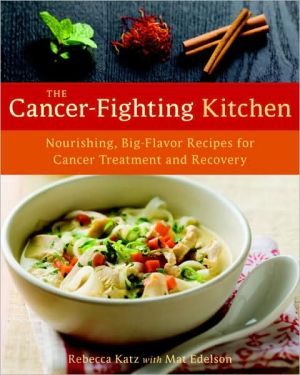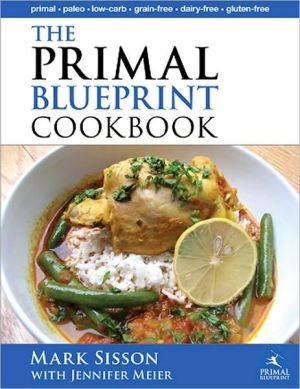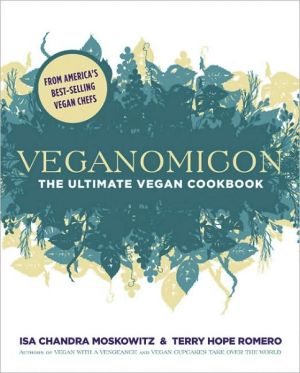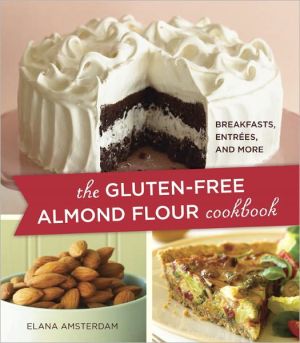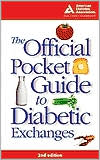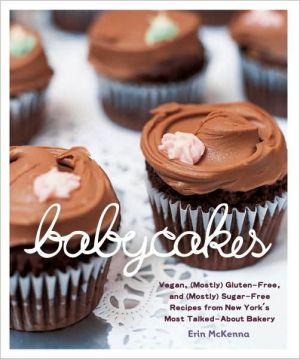Cancer-Fighting Kitchen: Nourishing, Big-Flavor Recipes for Cancer Treatment and Recovery
A Culinary Pharmacy in Your Pantry\ The Cancer-Fighting Kitchen features 150 science-based, nutrient-rich recipes that are easy to prepare and designed to give patients a much-needed boost by stimulating appetite and addressing treatment side effects including fatigue, nausea, dehydration, mouth and throat soreness, tastebud changes, and weight loss. A step-by-step guide helps patients nutritionally prepare for all phases of treatment, and a full nutritional analysis accompanies each recipe....
Search in google:
A Culinary Pharmacy in Your PantryThe Cancer-Fighting Kitchen features 150 science-based, nutrient-rich recipes that are easy to prepare and designed to give patients a much-needed boost by stimulating appetite and addressing treatment side effects including fatigue, nausea, dehydration, mouth and throat soreness, tastebud changes, and weight loss. A step-by-step guide helps patients nutritionally prepare for all phases of treatment, and a full nutritional analysis accompanies each recipe. This remarkable resource teaches patients and caregivers how to use readily available powerhouse ingredients to build a symptom- and cancer-fighting culinary toolkit. Blending fantastic taste and meticulous science, these recipes for soups, vegetable dishes, proteins, and sweet and savory snacks are rich in the nutrients, minerals, and phytochemicals that help patients thrive during treatment.Whole foods, big-flavor ingredients, and attractive presentations round out the customized menu plans that have been specially formulated for specific treatment phases, cancer types, side effects, and flavor preferences. The Cancer-Fighting Kitchen brings the healing power of delicious, nutritious foods to those whose hearts and bodies crave a revitalizing meal.The Cancer-Fighting Kitchen took home double honors at the prestigious IACP 2010 Awards, named a winner in both the Health and Special Diet category and the People’s Choice Award. Publishers Weekly Starred Review. Cancer treatments such as surgery, chemotherapy and radiation can be almost as hard on the body as the disease itself, and detailed nutrition advice is usually not on the program. This informative guide to fighting cancer from the inside out, from the senior chief at Marin County's Commonweal Cancer Help Program, corrects that with a wealth of easy, immediate steps to speed up the healing process through diet. The duo offer advice on treatment prep as well as solutions to common side effects like dehydration, fatigue and nausea. Caregivers should scour the first third, which describes in detail the treatment process, and includes an alphabetical list of cancer-fighting ingredients like blueberries, chocolate, honey and salmon, a reference for the 150 recipes that follow. Recipes for soups, broths and simple, satisfying dishes like Chicken and Rice are welcome, but the text is most helpful for an array of quick, nutritious snacks, like nutrient-rich granola bars or a cooling Cantaloupe Granita with Mint (especially useful for cravings, which are also addressed). Katz's experience with cancer patients and their long, often frustrating recovery lends authority to her wise, common-sense approach, suitable for cooks of all skill levels. Copyright © Reed Business Information, a division of Reed Elsevier Inc. All rights reserved.\\
Introduction\ \ If you’ve picked up this book, it’s probably because you or someone very close to you is going through a difficult time. A cancer diagnosis and the prospect of cancer treatment is scary, even for the most upbeat soul. There are probably a million questions and thoughts running around your head, and while I can’t address them all, I can speak to one: Am I going to enjoy eating during treatment? Heck, am I going to be able to eat at all?\ This book is all about enhancing your appetite during treatment, and much more. For me, the key concept is something I think of as “the power of yum,” a phrase I’ve used throughout my career as a “culinary translator,” if you will. I work with oncologists, nutritionists, and cancer wellness professionals to help their patients stay well fed during treatment by translating nutritional recommendations into delicious, nourishing meals. To me, this was always the power of yum in action: showing people that great nutrition and great taste could join together joyously on the same plate. Working with cancer patients for the past decade, I’ve seen heartening results. People who had truly disconnected from food could be brought back to the table and nourished, so long as the food was appealing to all the senses; was presented in a manner that fit their often shifting tastes and appetite (think small, nutrient-dense portions that are easily stored and reheated); and could easily be shopped for, prepped, and cooked by either the patient or their caregivers.\ If that was all there was to the power of yum, I’d be eternally grateful. It turns out that this is only half of the story. Over the past five years, the study of nutrition has expanded, exploded really, especially when it comes to understanding the many incredible properties foods have to fight cancer and limit the side effects of treatment. This isn’t fly-by-night science either; it’s the result of thousands of credible studies done by the country’s finest academic research institutes and presented in first-rate peer-reviewed scientific journals such the New England Journal of Medicine and the Journal of the American Medical Association.\ As a chef, I’ve been awed by this data and, truth be told, a little intimidated. I intuitively and experientially understood how taste and flavor could positively affect the people I worked with. It had long been known that as many as 80 percent of cancer patients were malnourished, in some cases leaving them too weakened to withstand ongoing treatment. By keeping them nourished with healthy foods, both the patients and I knew they stood a better chance of making the transition from patient to survivor.\ Still, it seemed like a new study was coming out every week on this food or that, and all of this nutritional data was a bit confusing to me. And from the conversations I had with clients, I knew it was confounding to them at times. Yet this information held such promise that I decided I’d better learn to talk the talk. I was excited at the prospect of being able to make dishes that not only tasted great, but could make someone with a specific side effect feel better.\ So I went and got a masters in nutrition, not to impress my clients, but to be able to converse with those doctors and scientists working in the trenches with these foods to get a feel for where the research and the cancer-food connection was strong and where it wasn’t, and so I could translate all that information into more outrageously scrumptious dishes to lure people in treatment back to the table.\ The result of this melding of science and taste is the cookbook and resource you hold in your hands. It’s the culmination of conversations with what I think of as my counsel of experts: more than a dozen of the best minds in medical and cancer wellness in the country. Each of these individuals sees nutrition and food as a vital, complementary part of their healing arsenal, a tool that patients themselves can use to keep their bodies and minds in optimal shape while enduring treatment.\ That last point is so crucial. A cancer diagnosis is shocking, disorienting, and capable of scrambling anybody’s mental GPS. To find a stabilizing force, a grounding activity such as cooking and eating well can provide more than nourishment; it can offer a huge psychological boost.\ Jeanne Wallace, PhD, a researcher and expert in cancer nutrition, articulates this idea of sustenance beautifully. Jeanne’s voluminous, meticulously researched, personalized action plans for her clients in treatment include numerous food recommendations to combat their cancer. She says, “When you get a cancer diagnosis, suddenly you become a very powerless person. You’re traipsing through the hospital as a name and number, people do all kinds of procedures to you, and you have a life-threatening condition, which many doctors maintain you have no control over. So when I’m handing someone their plan, saying, ‘You could make some changes with your diet and it would give you some sense of empowerment,’ many of my clients are so willing to do that. They embrace the sense of not being powerless, that even though they might not have total control over the cancer, they do have some influence.”\ Defining that potential influence is fascinating. Can what you eat really affect cancer? Professor Jim Gordon, MD, founder and director of the Center for Mind-Body Medicine in Washington, DC, sponsors several annual symposia that address the issue. His Cancer Guides training and Food as Medicine programs attract hundreds of doctors from across the country, including top integrative oncologists, internists, and other cancer wellness professionals. Gordon, a pioneer in the use of nutrition to impact cancer, uses a bit of scientifically informed common sense when asked if what he teaches makes a difference. “People with cancer are told by their oncologists, ‘This is the treatment: surgery, chemotherapy, radiation, maybe even immune therapy. Everything else is regarded as, at worst, unnecessary, peripheral, or, at best, complementary. . . . ’I think that’s a major misconception. The data in standard textbooks on nutrition and cancer is that cancer is related in some way to nutrition. It stands to reason that if nutrition is a significant factor in the development of cancer, you would want there to be to a focus on nutrition as part of the treatment and the prevention of recurrence in cancer.” Gerry Mullin, MD, a contributing editor to Nutrition in Clinical Practice, agrees: “Cancer is a consequence of the complex interplay of genes and environment on the immune system, and diet, as part of the environment, plays a role that can influence cancer’s development and treatment.”\ A key area of nutritional research is looking at the environment in which tumors function within the body. Part of what makes cancer such a difficult foe is its ability to send out signals that divert vital resources, such as blood and energy, for its own nefarious purposes. Researchers are now looking at how various nutrients in food--especially plant-based foods, spices, and herbs, with their abundant phytochemicals--can block cancer’s communication. If we can cut off this internal dialogue, tumors may become much more vulnerable to treatment.\ Integrative oncologist Donald Abrams, director of clinical programs for the Osher Center for Integrative Medicine at the University of California, San Francisco (UCSF), tells his patients by way of analogy that when it comes to cancer, it’s perfectly acceptable to be a bad host. In fact, it’s encouraged. “I tell them that cancer is a weed, you’re the garden, and our job is take make your soil as inhospitable as possible to further growth and spread of the weed. The first approach I take is through diet and nutrition.”\ The wonderful aspect of this work is that so many common foods--everything from broccoli to blueberries--have multiple cancer-fighting properties, including controlling blood sugar so you avoid insulin issues and obesity, which are major secondary risk factors for cancer. Similarly, everyday herbs and spices ranging from ginger to cinnamon to turmeric can help quell side effects ranging from nausea to fatigue. If you’d like to learn more about these properties, see the Culinary Pharmacy, page 28, where we’ve detailed the beneficial properties of most of the foods used in the recipes in this book. We’ve included the science because many of my clients get interested in the particulars once they realize how much better they often feel as they become well nourished. Still, others couldn’t care less about the science; they just want to be able to eat something, anything, because during treatment, their appetite has left the building.\ First and foremost, I’m a chef and a teacher who believes everyone has the ability to nourish themselves, even in the most dire of circumstances. This book was designed to meet you wherever you are in your treatment journey. If you just want to eat without giving a second thought to nutrition, worry not; every recipe in this book was created to be a nutrient-dense, delicious powerhouse, full of what your body needs to support your immune system, which is called upon to do yeoman’s work during treatment.\ The Cancer-Fighting Kitchen emphasizes what’s known as a whole foods approach. As the name suggests, whole foods come straight from the farm to the table with their nutrients intact, unlike refined and processed foods, such as white flour and sugar, which are stripped of so much of their nutritional value. (I call them empty calories).\ In addition to offering the broadest range of nutrients, the whole foods approach serves another purpose. People often ask me, “If science knows specific foods that fight cancer, why don’t I just eat those?” Ah, if only a single food had such abilities. But that’s not the way it works . . . at least not yet. Eating a wide variety of foods allows you to hedge your bets, as each of us absorbs nutrients differently. Since we haven’t gotten to the point yet where we can identify which specific foods work best for each individual, a wide-ranging diet is the only way to guarantee you’ll get the nourishment you need.\ I realize I’ve just put a lot on your plate. Now let me put your mind at ease. I understand that stepping into the kitchen to cook for someone with cancer (whether that’s you or someone else) takes a lot of courage. You so want them to like the food so they’ll eat. I’m here to let you know I’ll be holding your hand all the way. Life is serious enough for you and your loved ones right now. Although this book deals with a difficult topic, it comes at eating from a stance of joy and fun. Believe me, when you see the results--and the healing effect they have on all who partake--your motivation to get into the kitchen will take a quantum leap.\ When people ask me what I enjoy most about my work, I tell them I love being what I call a culinary translator. To me, that means really listening to my clients’ hopes and dreams for eating well, and then, using my culinary experience and education, helping them to develop the practical kitchen skills, nourishing recipes, and support systems (like learning how to shop a farmers’ market without fear) that make their desires a reality. It’s a role I relish and that I’ve brought to the fore in this book. Similarly, my coauthor, Mat Edelson, is a whiz at taking complex medical topics and explaining them in language that’s informative, entertaining, and easy to understand.\ It’s not only our voices you’ll hear in this book, but that of experts who have dedicated their careers to helping patients to live and eat well during treatment. You’ll also see tips from the real voices of experience, those who have personally dealt with cancer and want to share what they’ve learned about eating and other ways to stay well during treatment. Like me, they all believe in the power of yum. I’m hoping that as you read and use this book, you’ll come to believe in it too.\ How to Use This Book\ \ The most important advice I have on how to use this book is to have fun. So many things following a cancer diagnosis are chores; eating from this book shouldn’t be one of them. There are probably going to be days when swallowing a few sips of broth is going to be an accomplishment. By all means, celebrate that nourishment. Don’t beat yourself up for the meals you miss. When you accentuate the positive, your connection to food will remain intact during treatment and even build upon itself.\ Think of this book as a toolbox, full of great ideas that can entice you to eat with a minimum of stress in the kitchen for whoever is cooking. Will you utilize every tool in the box? Perhaps--but it isn’t necessary. I’ve tried to be all-inclusive because I want to give you ways to address issues that commonly crop up during treatment.\ Chapter 1, Cancer-Fighting Tool Kit, is a guide to scrumptious foods, recipes, and kitchen techniques that can lessen the impact of side effects, improve appetite and immunity, and overcome changes in the sense of taste or impaired taste buds, which is a common consequence of treatment. It includes very specific suggestions on what to eat before, during, and after chemotherapy. I’ve also included a questionnaire that’s a simple way to figure out people’s food preferences--your own or, if you’re a caregiver, someone else’s. Treatments can throw people’s tastes for such a loop that old favorites may not be appetizing. When that’s the case, knowing more about the person’s inherent preferences is valuable information. Chapter 1 also includes information on what I call global flavorprints--lists of herbs and spices that characterize different cuisines--and an introduction to the powerhouse foods used in the recipes, including their amazing cancer-fighting properties and other nutritional effects. I call this the culinary pharmacy, and it’s an incredibly powerful prescription for both health and appetite.\ Chapter 2, Strategies for Thriving during Treatment, sets out a game plan for making sure that everyone is on the same page and that as many people as possible get involved in the process. Cancer is such an emotional experience that the joy of caregiving can be jeopardized if organization and communication aren’t brought to the process. I’ll show you how to organize a culinary support team to cover shopping and cooking tasks, and how to clearly define roles so people don’t step on each other’s toes--and, most importantly, the patient’s. The guidance in chapter 2 will allow everyone to contribute in a way that’s desired and appreciated. On a practical level, this chapter will show you how to make sure a wide variety of healthy, yummy meals and snacks are available whenever hunger hits, even in settings outside the home, such as at work, in the hospital, or during treatment sessions. Eating small portions often is the best route for delivering nourishment to the body during treatment. And it gives detailed instructions on various food preparation techniques, and advice on storage and reheating.\ For those without easy access to a farmers’ market or well-stocked grocery stores, the Resources section provides online sources for many of the ingredients in the recipes. It also includes information on cancer support groups and medical information. The extensive bibliography documents sources for the information used in this book.\ As for the recipes and variations that are the heart and soul of the book, they have been tried and tested more times than I can count, by a battery of tasters who refused to be satisfied until they were moaning with delight. You’ve paid for a cookbook with the expectation that every recipe will deliver in terms of both taste and nutrition; my team and I have done the utmost to meet, and hopefully exceed, those expectations.\ Throughout the recipes, you’ll find suggestions on substitutions for common food sensitivities. For those who want to avoid dairy, you can generally use soy or rice milk--just be sure to use an unsweetened variety. Folks with gluten intolerance will find substitutions for wheat, as well.\ Whenever possible, I suggest eating organic for all of my clients, and that’s especially important for people in treatment, particularly when it comes to meat and dairy. I realize organics can cost a bit more across the board, but consider that undergoing treatment means you’re already dealing with plenty of toxins in your body. It makes sense to me that you don’t want to introduce more, in the form of pesticides, hormones, antibiotics, and other drugs, in your food. Plus, organically grown produce raised outdoors without pesticides produces phytochemicals to protect itself from the environment, and one school of scientific thought holds that many of these same chemicals offer chemoprotective benefits in the body. Either way, here’s one thing I can tell you for sure: organic, fresh-picked produce, pasture-raised chicken, and fish caught in the wild are absolutely delicious, offering the finest flavors that can land on your plate. Speaking as a chef and the little pixie in your ear, why would you settle for anything less?
ContentsForeword • vii Acknowledgments • ix Introduction • 1Chapter 1: Cancer-Fighting Tool Kit • 8Chapter 2: Strategies for Thriving during Treatment • 42Chapter 3: Nourishing Soups and Broths • 52Chapter 4: Vital Vegetables • 76Chapter 5: Protein-Building Foods • 100Chapter 6: Anytime Foods • 124Chapter 7: Tonics and Elixirs • 154Chapter 8: Dollops of Yum! • 172Chapter 9: Sweet Bites • 190Resources • 208Bibliography • 213Index • 217
\ Publishers WeeklyStarred Review. \ Cancer treatments such as surgery, chemotherapy and radiation can be almost as hard on the body as the disease itself, and detailed nutrition advice is usually not on the program. This informative guide to fighting cancer from the inside out, from the senior chief at Marin County's Commonweal Cancer Help Program, corrects that with a wealth of easy, immediate steps to speed up the healing process through diet. The duo offer advice on treatment prep as well as solutions to common side effects like dehydration, fatigue and nausea. Caregivers should scour the first third, which describes in detail the treatment process, and includes an alphabetical list of cancer-fighting ingredients like blueberries, chocolate, honey and salmon, a reference for the 150 recipes that follow. Recipes for soups, broths and simple, satisfying dishes like Chicken and Rice are welcome, but the text is most helpful for an array of quick, nutritious snacks, like nutrient-rich granola bars or a cooling Cantaloupe Granita with Mint (especially useful for cravings, which are also addressed). Katz's experience with cancer patients and their long, often frustrating recovery lends authority to her wise, common-sense approach, suitable for cooks of all skill levels.\ Copyright © Reed Business Information, a division of Reed Elsevier Inc. All rights reserved.\\\ \ \ \ \ \ Library JournalCancer treatments are infamous for destroying appetites, which inhibits patients from fighting their diseases and maintaining control and quality in their lives. Katz (senior chef, Commonweal Cancer Help Program) draws on her experience with and feedback from patients and cancer professionals to explain how foods can be used to battle cancer. She recommends whole organic foods rather than heavily processed products, detailing herbs, spices, and foods that can lessen specific side effects. The explanations of how to modify recipes to accommodate altered tastes are excellent. A questionnaire of food preferences helps caregivers and patients find best personal choices, and strategies for coping and thriving during treatment are described. With more than 150 easy recipes, including substitutions and ways to tailor flavors, plus resources for specialty ingredients, nutrition information, and recommended reading.\\\ \
